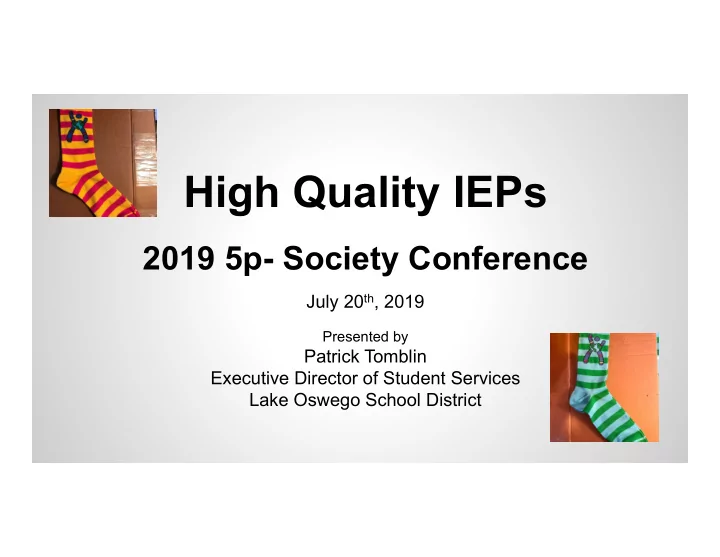

High Quality IEPs 2019 5p- Society Conference July 20 th , 2019 Presented by Patrick Tomblin Executive Director of Student Services Lake Oswego School District
AGENDA • Introductions & Agenda • IEP Meeting Basics – Things to Consider • Demographics & Meeting Participants • Special Factors & Present Levels • Transition • Assessment & Accessibility Supports • Annual Goals and Objectives • Service Summary, Placement, ESY • Resources
IEP Meeting Basics-Things to Consider ● Relationships Are Key ● We Are All Working To Help The Student Succeed ● The IDEA Provides Operating Rules For Schools/Districts And Parents
IEP Meeting Basics-Things to Consider ● It’s Not Personal/Stay Student Focused ● Go Off-line if needed ● Respect Each Other And The Challenges We Face In Doing The Work We Do (Kind Words!)
DEMOGRAPHICS
MEETING PARTICIPANTS
SPECIAL FACTORS
PRESENT LEVELS Most Important Part of the IEP ● It tells us about the student ● It tells us what you as parents want for your student. ● PINS – Preferences, Interests, Needs, Strengths ● Progress on previous goals ● Present level includes narrative and supporting data….Specific data driven
PRESENT LEVELS Sources of Data…
PRESENT LEVELS What does your IEP team ask from you as a parent for input? What questions do you ask?
PRESENT LEVELS Input From the Parents
TRANSITION PLANNING What is DIFFERENT about an IEP for a student with transition needs than a younger student? Hint - Which IEP components are required for transition students that aren’t for others? There are 8…
TRANSITION PLANNING 1. Student 2. Age Appropriate Transition Assessment 3. PINS - Preferences, Interests, Needs and Strengths 4. Post-Secondary Goals - Education, Training, Employment, and when appropriate, Independent Living 5. Transition Services 6. Course of Study 7. Annual Goals 8. Adult Service Agency
TRANSITION PLANNING Questions to consider when writing a post-secondary goal: • Does it occur after high school ? • Is it measurable ? • What is the education goal? • What is the training goal? • What is the employment goal? • What is the independent living goal?
ASSESSMENT
ASSESSMENT
ASSESSMENT ● All accessibility supports are accommodations under IDEA, thus all supports should be documented (Universal Tools, Designated Supports, and Accommodations) ● If a student receives an accommodation on the statewide assessment, it should also be an accommodation he/she receives during instruction
ASSESSMENT Modified Cut Scores: ● An IEP team may determine an alternate score on the statewide assessment for GRADUATION PURPOSES ONLY ● This is an INDIVIDUAL score, and should be based on a review of student data and present levels of performance ● Teams may change this score at any point ● Modified cut scores may NOT be used for Essential Skills for a standard diploma (only modified diploma)
Annual Goals What is the difference? ● Measurable Annual Goal ● Measurable Short-Term Objective
Annual Goal The overarching Goal the IEP team wants to improve • Typically the core content or overall life skill/ vocational area. • Reading comprehension, Fluency, Nutrition, Accessing public transportation……..
Short Term Objectives OAR 581-015-2000(34): Short Term-objectives means measureable intermediate performance steps that will enable parents, students and educators to gage, at intermediate times during the year how well the child is progressing toward the annual goals by either: a. Breaking down the skills described in the goal into discrete components, or b.Describing the amount of progress the child is expected to make within specified segments of the year
SAMPLE GOAL 1 - Reading
Goals and Objectives • Should be based on data within the PLOP (Baseline Data) • If it’s a new skill set a duration to collect baseline data. • Objectives show a direct correlation to the achievement of the goal. • SMART – Specific, Measurable, Achievable, Relevant and Time specific
Goals and Objective • Avoid the Kitchen Sink approach/ Realistic for one year. • Not only about learning the skill/Application of the skill. • How does it support the “End Game”? • Goals and Service Times Drive Placement
SERVICE SUMMARY
Placement • Least Restrictive Environment • Inclusion • FAPE
EXTENDED SCHOOL YEAR (ESY)
OVERVIEW OF RESOURCES ● IDEA Legacy - http://idea.ed.gov/explore/home ● OSEP Dear Colleague Letters - http://www2.ed.gov/policy/speced/guid/idea/letters/revpolicy/index.html ● Federal Register - http://idea.ed.gov/download/finalregulations.pdf ● Oregon Administrative Rules (OARs) - http://arcweb.sos.state.or.us/pages/rules/oars_500/oar_581/581_tofc.html 581-015-XXXX o 581-022-XXXX o ● OR Revised Statutes (ORS) - http://www.oregonlaws.org
OVERVIEW OF RESOURCES ● Oregon IEP / Toolkit / Guidance Document / Standards-Based IEPs / Transition / Accessibility Manual https://www.oregon.gov/ode/students-and- family/SpecialEducation/publications/Pages/Oregon-Standard- IEP.aspx
Recommend
More recommend